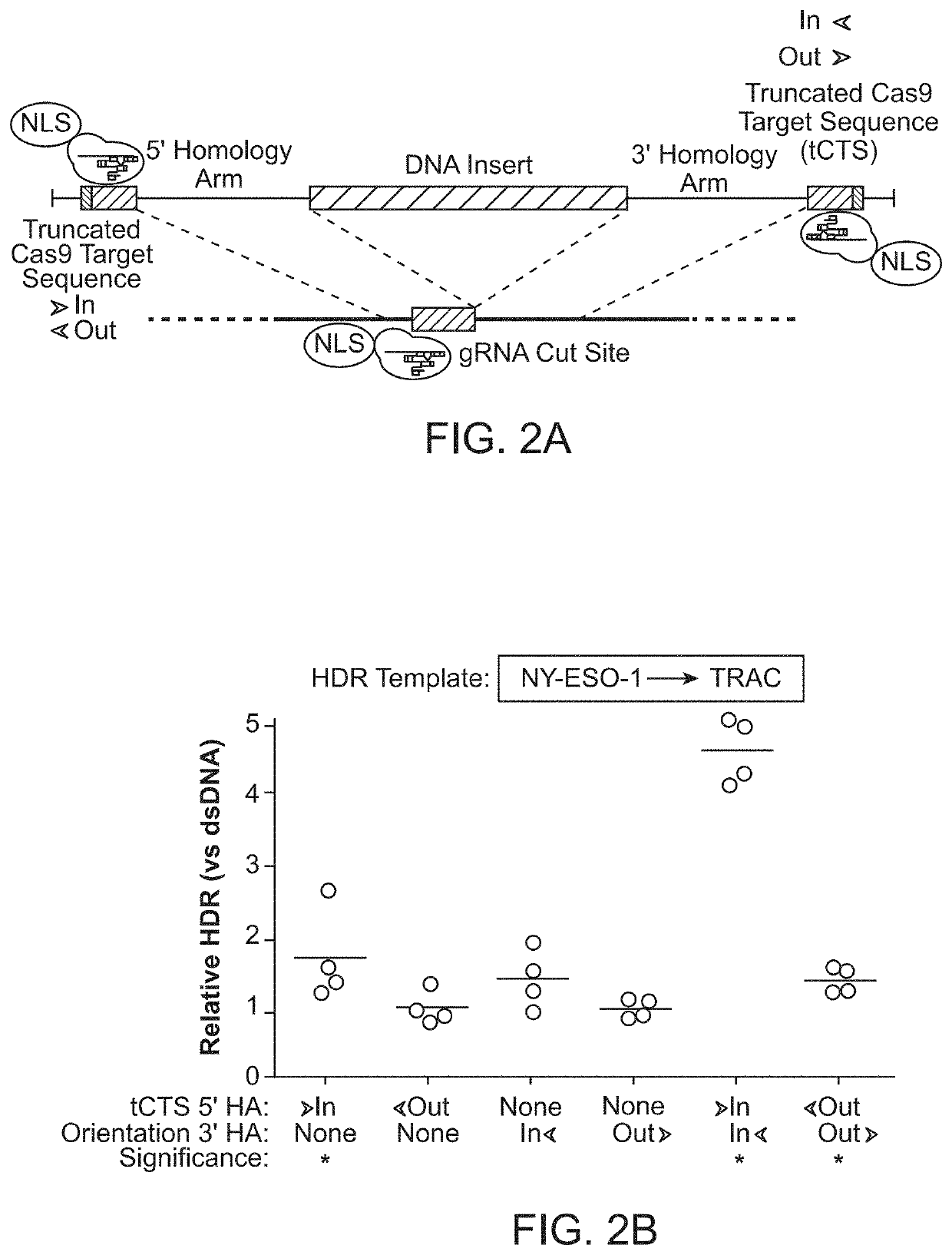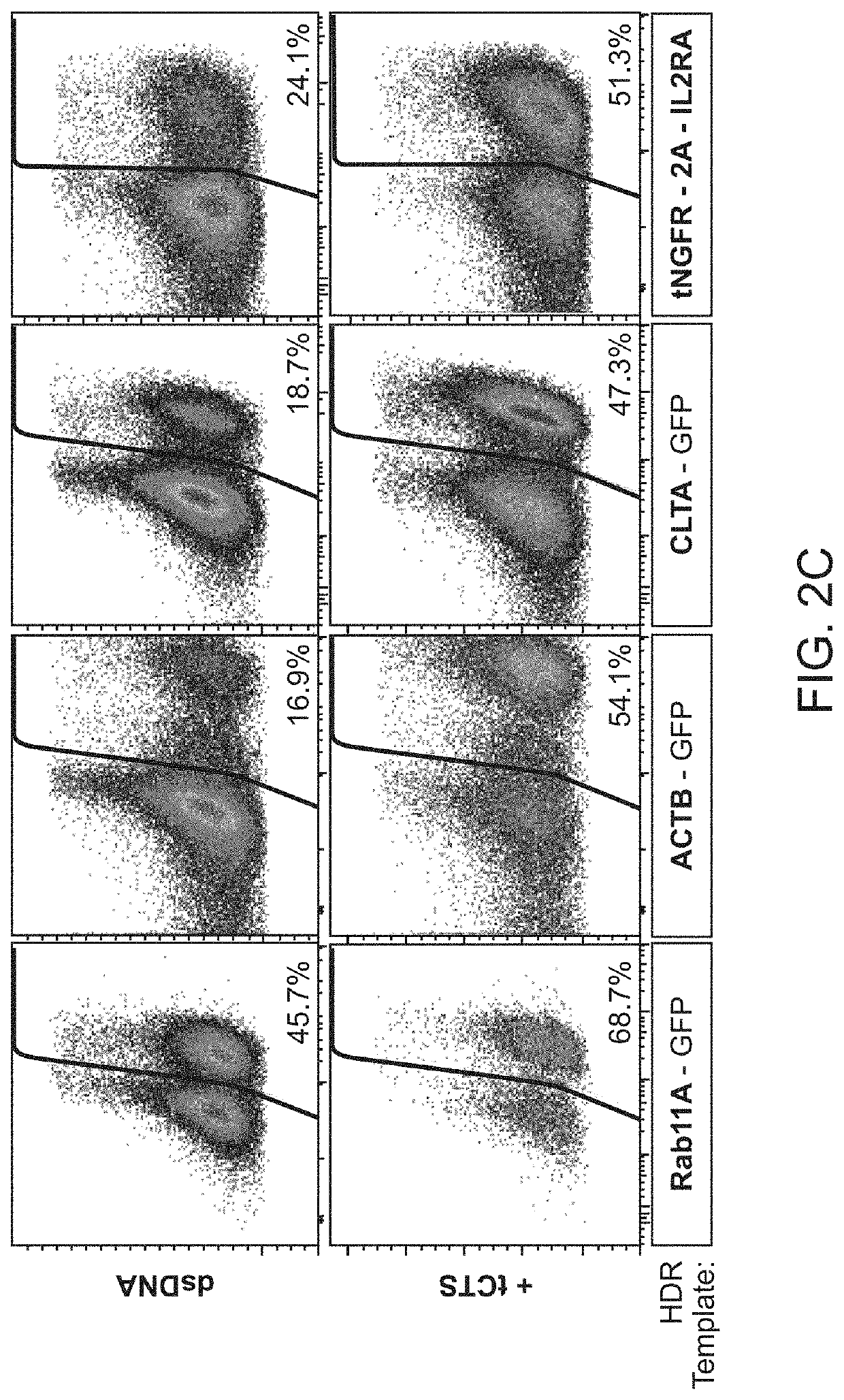Compositions and methods for modifying a target nucleic acid
a nucleic acid and target technology, applied in the field of compounding and methods for modifying a target nucleic acid, can solve the problems of gene overexpression, clinical trials have had unintended consequences, complications of viral delivery vectors, etc., to improve knock-in efficiency, improve knock-in efficiency, and improve the effect of delivery of the hdr templa
- Summary
- Abstract
- Description
- Claims
- Application Information
AI Technical Summary
Benefits of technology
Problems solved by technology
Method used
Image
Examples
example 1
tal Methods
[0200]Cell Culture
[0201]Primary adult cells were obtained from healthy human donors from leukoreduction chamber residuals after Trima Apheresis (Blood Centers of the Pacific) or from freshly drawn whole blood under a protocol approved by the UCSF IRB (BU101283). Peripheral blood mononuclear cells (PBMCs) were isolated by Ficoll-Paque (GE Healthcare) centrifugation using SepMate tubes (STEMCELL, per manufacturer's instructions). Specific lymphocytes were then further isolated by magnetic negative selection using an EasySep Human B Cell, CD4+ T Cell, CD3+ (Pan) T Cell, CD8+ T cell, CD4+ CD127low CD25' Regulatory T Cell, Gamma / Delta T Cell, or NK Cell Isolation kit (STEMCELL, per manufacturer's instructions).
[0202]Isolated CD4+, CD8+, CD3+ (Bulk T Cells), Regulatory (CD25hiCD127low), or Gamma / Delta T cells were activated and cultured for 2 days at 0.5 to 1.0 million cells / mL in XVivo 15 medium (Lonza) with 5% Fetal Bovine Serum, 50 mM 2-mercaptoethanol, 10 mM N-Acetyl L-Cyst...
example 2
of a DNA-Binding Protein Target Sequence to the HDR Template
[0210]An approach to reprogram human T cells with CRISPR-based genome targeting without the need for viral vectors (Roth et al., Nature 559:405-409, 2018) was previously reported. However many research and clinical applications still depend upon improved efficiency, cell viability, and generalizability of non-viral genome targeting across cell types (Yin et al., Nat Rev Clin Oncol, 16(5):281-295, 2019; Dunbar et al., Science 359:6372, 2018; Cornu et al., Nat Med 23:415-423, 2017; and David and Doherty, Toxicol Sci 155:315-325, 2017). It was previously found that varying the relative concentrations of both Cas9 RNP and HDR template had significant effects on targeting efficiency and toxicity (Roth et al., Nature 559:405-409, 2018). Here, an initial experiment was conducted to optimize the interactions between the HDR template and stabilized RNPs to see if further improvements could be made independent of cell type.
[0211]The ...
example 3
DNA-Binding Protein Target Sequence on Genome Targeting Efficiency
[0212]It was hypothesized that a single catalytically-active Cas9-NLS RNP would suffice for both on-target genomic cutting and “shuttling” if a truncated (16 bp) DNA-binding protein target sequence was added to the HDR template. A truncated DNA-binding protein target sequence would enable Cas9 binding but not cutting (Jiang and Doudna, Annu Rev Biophys 46:505-529, 2017) (FIG. 2A and FIGS. 3A-3D). With the proper sequence orientation, the additional DNA-binding protein target sequence markedly improved the efficiency of knocking-in a reprogrammed TCRα and TCRβ specificity (with a ˜1.5 kb DNA insert) at the endogenous TRAC (T-cell receptor a constant) locus (FIG. 2B and FIGS. 3A-3D). This DNA-binding protein target sequence shuttle system improved genome targeting efficiencies across a variety of loci in different primary human T cell types (FIGS. 2C and 2D and FIGS. 4A-4E). HDR templates with the DNA-binding protein ta...
PUM
| Property | Measurement | Unit |
|---|---|---|
| molecular weight | aaaaa | aaaaa |
| molecular weight | aaaaa | aaaaa |
| temperature | aaaaa | aaaaa |
Abstract
Description
Claims
Application Information
 Login to View More
Login to View More - R&D
- Intellectual Property
- Life Sciences
- Materials
- Tech Scout
- Unparalleled Data Quality
- Higher Quality Content
- 60% Fewer Hallucinations
Browse by: Latest US Patents, China's latest patents, Technical Efficacy Thesaurus, Application Domain, Technology Topic, Popular Technical Reports.
© 2025 PatSnap. All rights reserved.Legal|Privacy policy|Modern Slavery Act Transparency Statement|Sitemap|About US| Contact US: help@patsnap.com



